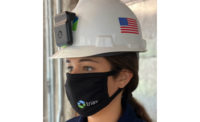
In construction, radio-frequency identification devices, or RFIDs, are used for security purposes to monitor jobsites and track workers. At Peru's Port of Callao, the largest port on the Pacific side of South America, RFID technology is being used to avoid collisions between workers and loading equipment.
"In most ports all over the world, there has, for many years, been a problem to effectively separate the men from the machines," says Henrik Kristensen, APM Terminals chief executive in Callao, whose company worked with RFID manufacturer Avonwood Developments Ltd., U.K., to perfect the ZoneSafe proximity warning system at the port.
"We made a lot of efforts to avoid accidents through instruction and training with some success, but we were looking for technology that [could] help," says Kristensen.
At the port, just three to four well-placed transponder sensors are mounted on every piece of equipment, such as forklifts and reach stackers, says Kristensen. The transponders provide an invisible, adjustable 30-ft-wide detection zone around each piece of equipment. When a worker—equipped with an RFID tag sewn into their clothes or embedded in their jobsite ID—walks into a detection zone, lights and alarms go off both inside and outside the cab.
Kristensen's team helped Avonwood customize its system to the Port of Callao's operational needs during more than eight months of real-world testing. In the end, the APM Terminals and Avonwood team changed the frequency and placement of the transponder sensors. Kristensen says they had to make sure the alarm was loud enough to be heard even while the equipment was operating.
"We're the first container terminal to go live with these sorts of RFID safety measures," says Kristensen. "It costs about $8,000 to $10,000 per machine."
Kristensen believes a few thousand dollars isn't much to spare to create a buffer zone between machines and employees. "It allows you to avoid serious injuries and fatalities," he says.



Post a comment to this article
Report Abusive Comment